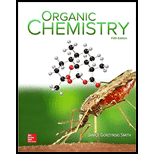
ORGANIC CHEMISTRY-MOLYMOD PACKAGE
5th Edition
ISBN: 9781260227307
Author: SMITH
Publisher: MCG
expand_more
expand_more
format_list_bulleted
Concept explainers
Textbook Question
Chapter 19, Problem 19.7P
Explain how you could use IR spectroscopy to distinguish among the following three compounds.

Expert Solution & Answer
Want to see the full answer?
Check out a sample textbook solution
Students have asked these similar questions
Show how IR spectroscopy can be used to distinguish between the compounds in the following set
How can you use UV spectroscopy to distinguish between the compounds in each of the following pairs?
How could IR spectroscopy be used to distinguish the following compounds?
Chapter 19 Solutions
ORGANIC CHEMISTRY-MOLYMOD PACKAGE
Ch. 19 - Prob. 19.1PCh. 19 - Problem 19.2 Give the structure corresponding to...Ch. 19 - Problem 19.3 Draw the structure corresponding to...Ch. 19 - Prob. 19.4PCh. 19 - Prob. 19.5PCh. 19 - Problem 19.6 Rank the following compounds in order...Ch. 19 - Problem 19.7 Explain how you could use IR...Ch. 19 - Prob. 19.8PCh. 19 - Problem 19.9 How many tetrahedral stereogenic...Ch. 19 - Problem 19.10 What alcohol can be oxidized to each...
Ch. 19 - Problem 19.11 Identify A-D in the following...Ch. 19 - Problem 9.12 Draw the cation that results when a...Ch. 19 - Problem 19.13 Draw the products of each acid-base...Ch. 19 - Problem 19.14 Given the values in Appendix A,...Ch. 19 - Problem 19.15 Rank the labeled protons in...Ch. 19 - Problem 19.16 Match each of the following values ...Ch. 19 - Problem 19.17 Rank the compounds in each group in...Ch. 19 - Problem 19.18 Rank the compounds in each group in...Ch. 19 - Prob. 19.19PCh. 19 - Problem 19.20 Which of the following pairs of...Ch. 19 - Problem 19.21 Two other commonly used sulfonic...Ch. 19 - Problem 19.22 Draw both enantiomers of each amino...Ch. 19 - Problem 19.23 Explain why amino acids, unlike most...Ch. 19 - Problem 19.24 Draw the positively charged,...Ch. 19 - Prob. 19.25PCh. 19 - Problem 19.26 Explain why the of the group of...Ch. 19 - Answer each question for A and B depicted in the...Ch. 19 - Prob. 19.28PCh. 19 - 19.29 Give the IUPAC name for each compound.
a....Ch. 19 - 19.30 Draw the structure corresponding to each...Ch. 19 - Prob. 19.31PCh. 19 - 19.32 Rank the following compounds in order of...Ch. 19 - 19.33 Draw the organic products formed in each...Ch. 19 - 19.34 Identify the lettered compounds in each...Ch. 19 - 19.35 Using the table in Appendix A, determine...Ch. 19 - 19.36 Draw the products of each acid-base...Ch. 19 - 19.37 Which compound in each pair has the lower ?...Ch. 19 - 19.38 Rank the compounds in each group in order of...Ch. 19 - 19.39 Rank the compounds in each group in order of...Ch. 19 - 19.40 Match the values to the appropriate...Ch. 19 - Prob. 19.41PCh. 19 - 19.42 Which carboxylic acid has the lower ,...Ch. 19 - Prob. 19.43PCh. 19 - 19.44 Explain the following statement. Although...Ch. 19 - Prob. 19.45PCh. 19 - 19.46 Explain why the of compound A is lower than...Ch. 19 - 19.47 Rank the following compounds in order of...Ch. 19 - Prob. 19.48PCh. 19 - Prob. 19.49PCh. 19 - 19.50 Draw all resonance structures of the...Ch. 19 - As we will see in Chapter 23, CH bonds are...Ch. 19 - Prob. 19.52PCh. 19 - The pKa of acetamide (CH3CONH2) is 16. Draw the...Ch. 19 - 19.54 Write out the steps needed to separate...Ch. 19 - Prob. 19.55PCh. 19 - Can octane and octan -1- ol be separated using an...Ch. 19 - 19.57 Identify each compound from its spectral...Ch. 19 - 19.58 Use the NMR and IR spectra given below to...Ch. 19 - 19.59 An unknown compound (molecular formula )...Ch. 19 - 19.60 Propose a structure for (molecular formula...Ch. 19 - 19.61 Match the data to the appropriate...Ch. 19 - Prob. 19.62PCh. 19 - Prob. 19.63PCh. 19 - Prob. 19.64PCh. 19 - 19.65 For each amino acid ,draw its neutral,...Ch. 19 - Calculate the isoelectric point for each amino...Ch. 19 - 19.67 Lysine and tryptophan are two amino acids...Ch. 19 - Prob. 19.68PCh. 19 - Prob. 19.69PCh. 19 - Prob. 19.70PCh. 19 - 19.71 Hydroxy butanedioic acid occurs naturally in...Ch. 19 - 19.72 Although it was initially sold as a rat...
Knowledge Booster
Learn more about
Need a deep-dive on the concept behind this application? Look no further. Learn more about this topic, chemistry and related others by exploring similar questions and additional content below.Similar questions
- How to distinguish the following compounds by infrared spectroscopyarrow_forwardPlease help with these two. Explain your reasoning and show calculation of degree of unsaturation. Also, draw the structure of each compound on IR/NMR spectrum.arrow_forwardHow do you interpret these IR and 1H NMR spectra without having a molecular formula?arrow_forward
- Identify the lettered compounds in the following reaction scheme. Compounds F, G, and K are isomers of molecular formula C13H18O. How could 1H NMR spectroscopy distinguish these three compounds from each other?arrow_forwardHow would compounds X and Y differ in their IR spectra?arrow_forwardNext, draw the structure of C7H14O with hydrogen NMR and IR and the location of NMR.arrow_forward
- Explain how you can distinguish the following molecules using ALL four techniques (mass spectrometry, IR spectrometry, 1H NMR, and 13C NMR). Note if a given technique will provide no means to distinguish the compounds.arrow_forwardSelect the unknown with the following information from 1H-NMR, IR and MS.arrow_forwardDraw the structure of an ether with formula C5H12O2 that fits the following NMR spectrum.arrow_forward
arrow_back_ios
arrow_forward_ios
Recommended textbooks for you
 EBK A SMALL SCALE APPROACH TO ORGANIC LChemistryISBN:9781305446021Author:LampmanPublisher:CENGAGE LEARNING - CONSIGNMENT
EBK A SMALL SCALE APPROACH TO ORGANIC LChemistryISBN:9781305446021Author:LampmanPublisher:CENGAGE LEARNING - CONSIGNMENT

EBK A SMALL SCALE APPROACH TO ORGANIC L
Chemistry
ISBN:9781305446021
Author:Lampman
Publisher:CENGAGE LEARNING - CONSIGNMENT
Mass Spectrometry; Author: Professor Dave Explains;https://www.youtube.com/watch?v=hSirWciIvSg;License: Standard YouTube License, CC-BY